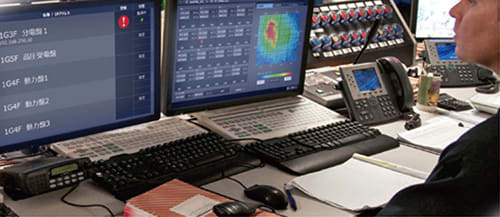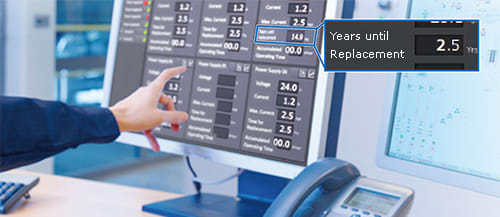
Dan Anderson
Product Manager
Omron Automation Americas
RS’s “Ask The Expert” series taps into the experience and expertise of key thought leaders and subject matter experts from the more than 500 global suppliers we work closely with to bring customers solutions for their most challenging problems (and the daily ones, too).
In this edition, we chat with Dan Anderson, Product Manager, Components at Omron Automation Americas to learn about the many benefits of implementing predictive maintenance strategies, as well as the innovative products Omron offers to aid customers beginning their predictive maintenance journey.
An Introduction to predictive maintenance: What exactly is predictive maintenance, and why is it so critical in today’s industries?
The idea of predictive maintenance is based in the Internet of Things (IoT), where everything is now interconnected through the Internet. Through this interconnection, information is shared across the network, and now information available at one location can be acted on at a different location. For example, a traffic light control system can now have full knowledge of the status of all the traffic lights in a city, decide trash pickup on demand, and integrate emergency services and dispatch as needed. All of these different systems are interconnected through the internet, and more of this information is available at our fingertips to act upon.
The next evolution of IoT is bringing that technology to industrial component products commonly used in multiple industries such as power supplies, electric motor monitoring, and heat condition monitoring. Having a way to continuously monitor these products in real-time for the symptoms before malfunction and failure greatly reduces or eliminates unplanned downtime. Additionally, it is helping to minimize the high maintenance costs of aging machinery and reducing the requirement on skilled maintenance workers. Predictive maintenance products make this possible.


Why is predictive maintenance important?
There are also predictive algorithms in the logic of many of our predictive maintenance products that can detect a condition before it has happened. For example, if there is loose wire in a power junction causing excessive heat, our K6PM thermal imaging solution will be able to predict the future temperature almost an hour in advance. If something is about to overheat, break or reach the end of its service life — such as a motor vibration analysis indicating too much bearing wear — Omron predictive monitoring products give notice that something is wrong, and using trending data, some of them can accurately predict how long until a problem occurs. Vibration analysis predictive maintenance and other Omron solutions give technicians an invaluable window of opportunity to act and save a great deal of downtime and financial loss.
How can companies determine if a predictive maintenance program is right for them? Are there cases where such a strategy may not be needed?
It really comes down to the question, “What is your yearly unplanned downtime cost?” When you compare those costs against the installation cost of a predictive maintenance solution, it’s an economical way of deciding if predictive maintenance is right for you.
Naturally, these costs vary significantly from manufacturer to manufacturer. Maintenance costs vary widely from minimum wage all the way up to $700,000+/hour for automotive car manufacturers. If a component or wear item fails and stops a machine from running, that is costing you money. Condition monitoring of that component or equipment enables you to determine service intervals before a malfunction occurs, as well as schedule maintenance and repairs during off hours when the equipment is not in use. Using these kinds of analyses are helpful in determining if a predictive maintenance program is right for someone’s unique situation.
The type of application or industry itself also needs to be considered. Where failure of equipment has the potential for loss of life, reliability and status is very important. An example are hospitals or facilities requiring ventilation, which could cause people to get sick or hurt should that ventilation fail. When you have a situation where equipment failure has a substantial impact on your operations, that’s when a predictive maintenance program can save you money and protect your company’s resources.
What is the typical cost of predictive maintenance implementation?
The costs will vary depending upon what is being monitored and how many pieces of equipment are being monitored. Many predictive maintenance products, like Omron’s, are easy to retrofit onto existing equipment, typically with a screw-in sensor, transformer clamp, or the attachment of a camera inside the control panel. Most setup and installation is easy for a beginner to accomplish, but Omron also has resources able to assist on directing installation, if required.
What are the main products in Omron’s predictive maintenance line, and what applications are they used for?
Omron currently has six predictive maintenance solutions available, and our product offerings continue to expand. The most prevalent is the S8VK-X, an Ethernet connected power supply that provides current operation status, condition and user-defined alerts to anywhere with an internet connection. In addition to user-defined condition alarms, the S8VK-X also communicates remaining lifetime till replacement.
The next three products in our line are designed specifically for three-phase motors, each solution addressing one of the three most common issues these motors have: bearing wear, overload/debris conditions, and insulation breakdown. Omron offers three different solutions in the K6CM product line that each focus on providing condition monitoring to identify these issues and alert the user on abnormalities. The K6CM-CI Motor Current Condition Monitor, for example, uses built-in algorithms to analyze motor current sine waves for deviations from the uniform sine wave. This can detect, say, debris in a motor, or a blockage in a water pump or pump cavitation resulting in equipment damage. The K6CM-VBM Vibration/Temperature Monitor, meanwhile, is designed to detect vibrations and unusual heat fluctuations that typically result from bearing wear. The third sensor, the K6CM-ISM Insulation Resistance Monitor, will preemptively detect insulation breakdowns, which if left unchecked can cause short out and potentially destroy a motor. All of these can be installed using a sensor or a clamp in just a couple minutes and come with free software that integrates with any laptop or controlling device, allowing users to view real-time statuses and trending data.
The final two products have broader applications. The K7GE Servo Motor Insulation Module provides insulation resistance monitoring similar to the K6CM-ISM, but it can be installed on single-phase and servo motors as well as three-phase motors. Any motor, any size. It also offers the option of monitoring up to eight motor probes with a single monitoring unit, as opposed to a single motor with the K6CM-ISM.
The K6PM Thermal Condition Monitor, meanwhile, uses a thermal imaging camera system to provide predictive maintenance information. The camera system has a 32×32 visual grid detecting the temperature of each cell and alerts the user when temperature exceeds target. Each monitoring device supports up to 31 cameras, so customers can install these devices across their factory and continuously monitor for thermal condition changes anywhere of interest. The K6PM uses a predictive algorithm that allows it to detect if the temperature will trigger a temperature alarm up to 58 minutes in advance. It is a cool feature. Additionally, our software can connect to up to five monitoring units, so that’s potentially 155 thermal imaging cameras supported by a single computer running the software!

S8VK-X

K6CM Product Line

K7GE

K6PM
Does Omron offer any additional resources to help customers learn more about predictive maintenance and if it is right for them?
We do! Omron’s Predictive Maintenance Solutions page helps customers get a general overview of predictive maintenance products and find more information on a specific solution. In addition, there are some real-world use cases and success stories, along with a white paper on predictive maintenance. We also offer an Unplanned Downtime vs. Predictive Maintenance ROI calculator to easily compare if predictive maintenance is right for you. And, of course, you can always call either our solutions team or your RS representative to help determine the right products for your unique application.
Additional Links:
- Omron predictive maintenance solutions available from RS
- Omron IO-Link series products
- Whitepaper: Remote condition monitoring of critical equipment
- Omron predictive maintenance video







